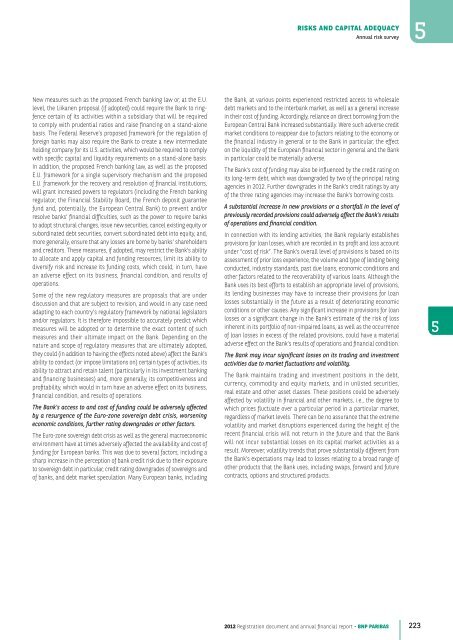2012 Registration document and annual financial report - BNP Paribas
2012 Registration document and annual financial report - BNP Paribas
2012 Registration document and annual financial report - BNP Paribas
- No tags were found...
Create successful ePaper yourself
Turn your PDF publications into a flip-book with our unique Google optimized e-Paper software.
RISKS AND CAPITAL ADEQUACYAnnual risk survey5New measures such as the proposed French banking law or, at the E.U.level, the Liikanen proposal (if adopted) could require the Bank to ringfencecertain of its activities within a subsidiary that will be requiredto comply with prudential ratios <strong>and</strong> raise financing on a st<strong>and</strong>-alonebasis. The Federal Reserve’s proposed framework for the regulation offoreign banks may also require the Bank to create a new intermediateholding company for its U.S. activities, which would be required to complywith specific capital <strong>and</strong> liquidity requirements on a st<strong>and</strong>-alone basis.In addition, the proposed French banking law, as well as the proposedE.U. framework for a single supervisory mechanism <strong>and</strong> the proposedE.U. framework for the recovery <strong>and</strong> resolution of <strong>financial</strong> institutions,will grant increased powers to regulators (including the French bankingregulator, the Financial Stability Board, the French deposit guaranteefund <strong>and</strong>, potentially, the European Central Bank) to prevent <strong>and</strong>/orresolve banks’ <strong>financial</strong> difficulties, such as the power to require banksto adopt structural changes, issue new securities, cancel existing equity orsubordinated debt securities, convert subordinated debt into equity, <strong>and</strong>,more generally, ensure that any losses are borne by banks’ shareholders<strong>and</strong> creditors. These measures, if adopted, may restrict the Bank’s abilityto allocate <strong>and</strong> apply capital <strong>and</strong> funding resources, limit its ability todiversify risk <strong>and</strong> increase its funding costs, which could, in turn, havean adverse effect on its business, <strong>financial</strong> condition, <strong>and</strong> results ofoperations.Some of the new regulatory measures are proposals that are underdiscussion <strong>and</strong> that are subject to revision, <strong>and</strong> would in any case needadapting to each country’s regulatory framework by national legislators<strong>and</strong>/or regulators. It is therefore impossible to accurately predict whichmeasures will be adopted or to determine the exact content of suchmeasures <strong>and</strong> their ultimate impact on the Bank. Depending on thenature <strong>and</strong> scope of regulatory measures that are ultimately adopted,they could (in addition to having the effects noted above) affect the Bank’sability to conduct (or impose limitations on) certain types of activities, itsability to attract <strong>and</strong> retain talent (particularly in its investment banking<strong>and</strong> financing businesses) <strong>and</strong>, more generally, its competitiveness <strong>and</strong>profitability, which would in turn have an adverse effect on its business,<strong>financial</strong> condition, <strong>and</strong> results of operations.The Bank’s access to <strong>and</strong> cost of funding could be adversely affectedby a resurgence of the Euro-zone sovereign debt crisis, worseningeconomic conditions, further rating downgrades or other factors.The Euro-zone sovereign debt crisis as well as the general macroeconomicenvironment have at times adversely affected the availability <strong>and</strong> cost offunding for European banks. This was due to several factors, including asharp increase in the perception of bank credit risk due to their exposureto sovereign debt in particular, credit rating downgrades of sovereigns <strong>and</strong>of banks, <strong>and</strong> debt market speculation. Many European banks, includingthe Bank, at various points experienced restricted access to wholesaledebt markets <strong>and</strong> to the interbank market, as well as a general increasein their cost of funding. Accordingly, reliance on direct borrowing from theEuropean Central Bank increased substantially. Were such adverse creditmarket conditions to reappear due to factors relating to the economy orthe <strong>financial</strong> industry in general or to the Bank in particular, the effecton the liquidity of the European <strong>financial</strong> sector in general <strong>and</strong> the Bankin particular could be materially adverse.The Bank’s cost of funding may also be influenced by the credit rating onits long-term debt, which was downgraded by two of the principal ratingagencies in <strong>2012</strong>. Further downgrades in the Bank’s credit ratings by anyof the three rating agencies may increase the Bank’s borrowing costs.A substantial increase in new provisions or a shortfall in the level ofpreviously recorded provisions could adversely affect the Bank’s resultsof operations <strong>and</strong> <strong>financial</strong> condition.In connection with its lending activities, the Bank regularly establishesprovisions for loan losses, which are recorded in its profit <strong>and</strong> loss accountunder “cost of risk”. The Bank’s overall level of provisions is based on itsassessment of prior loss experience, the volume <strong>and</strong> type of lending beingconducted, industry st<strong>and</strong>ards, past due loans, economic conditions <strong>and</strong>other factors related to the recoverability of various loans. Although theBank uses its best efforts to establish an appropriate level of provisions,its lending businesses may have to increase their provisions for loanlosses substantially in the future as a result of deteriorating economicconditions or other causes. Any significant increase in provisions for loanlosses or a significant change in the Bank’s estimate of the risk of lossinherent in its portfolio of non-impaired loans, as well as the occurrenceof loan losses in excess of the related provisions, could have a materialadverse effect on the Bank’s results of operations <strong>and</strong> <strong>financial</strong> condition.The Bank may incur significant losses on its trading <strong>and</strong> investmentactivities due to market fluctuations <strong>and</strong> volatility.The Bank maintains trading <strong>and</strong> investment positions in the debt,currency, commodity <strong>and</strong> equity markets, <strong>and</strong> in unlisted securities,real estate <strong>and</strong> other asset classes. These positions could be adverselyaffected by volatility in <strong>financial</strong> <strong>and</strong> other markets, i.e., the degree towhich prices fluctuate over a particular period in a particular market,regardless of market levels. There can be no assurance that the extremevolatility <strong>and</strong> market disruptions experienced during the height of therecent <strong>financial</strong> crisis will not return in the future <strong>and</strong> that the Bankwill not incur substantial losses on its capital market activities as aresult. Moreover, volatility trends that prove substantially different fromthe Bank’s expectations may lead to losses relating to a broad range ofother products that the Bank uses, including swaps, forward <strong>and</strong> futurecontracts, options <strong>and</strong> structured products.5<strong>2012</strong> <strong>Registration</strong> <strong>document</strong> <strong>and</strong> <strong>annual</strong> <strong>financial</strong> <strong>report</strong> - <strong>BNP</strong> PARIBAS 223





